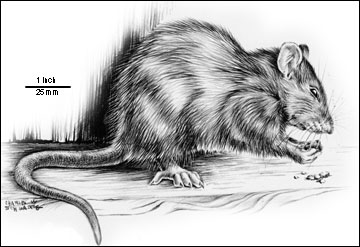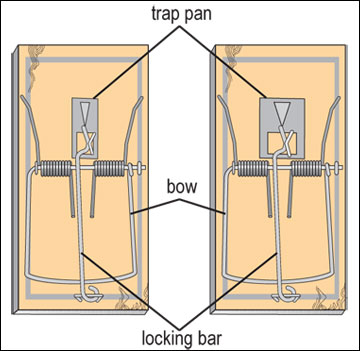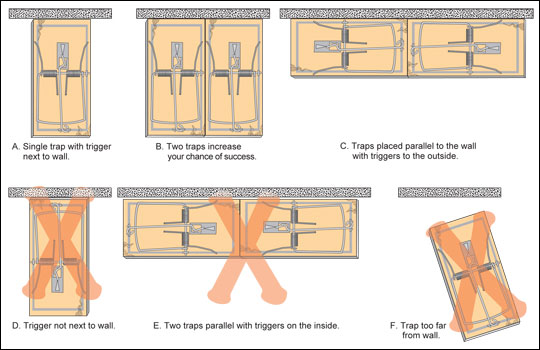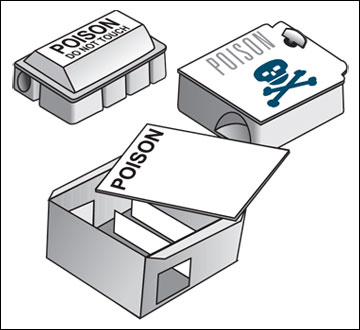
Norway rats (Rattus norvegicus) are stocky burrowing rodents that were unintentionally introduced into North America by settlers who arrived on ships from Europe (Figure 1). Also called brown rats or sewer rats, these destructive pests are found in and around towns and farms throughout Missouri. These rodents eat and contaminate large amounts of feed, and damage structures and insulation by their movements and gnawing activities. In addition, they can spread diseases that affect livestock and humans. Norway rats are not protected by law. They may be controlled with any pesticide registered in Missouri for rat control or by use of mechanical means such as traps. This guide provides information on how to recognize and manage a rat infestation.
When controlling a rat problem, or any wildlife damage problem, you need to understand the basic components of wildlife damage management:
- How to recognize damage patterns and identify the species responsible
- Biology of the species in relation to management and the damage occurring
- Management alternatives
- Local, state and federal laws and regulations
Refer to MU Extension publication G9425, Solving Wildlife Damage Problems in Missouri, for more information.
Rat biology
Rats are primarily active at night, or nocturnal. They have poor eyesight, but they have very keen senses of taste, hearing and smell. They will often climb to find food or shelter, and they can gain entrance to a building through any opening larger than 1/2 inch in diameter. They can enter structures by gnawing, climbing or jumping. They can also swim through sewers and enter through toilets or broken drainpipes.
Rats constantly explore and learn about their environment, memorizing the locations of pathways, obstacles, food, water, shelter and other elements in their domain. They can quickly detect and tend to avoid new objects placed in a familiar environment. Thus, objects such as traps and bait stations often are avoided for the first several days or longer after they are placed.
Rats are attracted to areas with ample amounts food and cover. They will eat nearly any type of food but prefer high-quality foods such as meats and fresh grains. They can survive quite well on an ounce of garbage or decayed food and an ounce of water daily. One rat can eat about 30 pounds of grain a year and may contaminate 10 times that much with its urine, feces and hair.
Rats breed most actively in spring and fall. Their young are born in 21 to 23 days and reach reproductive maturity in about three months. Female rats typically have litters of six to 12 young. The average female has four to six litters a year and can successfully wean more than 20 offspring a year.
Studies indicate that during its daily activities, a rat normally travels an area averaging 100 to 150 feet in diameter. Rats seldom travel farther than 300 feet from their burrows for food or water.
Recognizing rat infestations and estimating rat numbers
Rat movement is usually related to food, water and shelter. Knowing where they are likely to go is important to controlling them, and being able to recognize their presence is a first step towards solving a rat problem.

The presence of rats can be detected by droppings or evidence of fresh gnawing. Tracks can be seen in mud and on dusty surfaces. Runways and burrows may be found next to buildings, along fences and under low vegetation and debris (Figure 2). Rats prefer to use regular paths or runways along walls or behind debris. They are afraid of strange objects and strange foods and may avoid both.
Sounds such as gnawing, climbing in walls, squeaks and fighting noises are common where rats are present, particularly at times of the day when they are most active. Norway rats are burrowers, and they often dig in rubbish or garbage and under buildings or concrete slabs.
Rat signs and sightings are of limited value in accurately estimating how many rats are present, but they are the simplest and often the only practical methods available. When looking for rats, thoroughly search the premises, particularly in attics, crawl spaces and basements; around foundations; and behind and under stored materials.
Once rats have invaded your garden or landscape, it is only a matter of time before you find evidence of them indoors, unless your home is truly rodent-proof. Inspect your yard and home thoroughly and look for signs of rodent activity:
- Rat droppings
- Gnawing through wood on buildings or other structures
- Noises from the attic just after dusk
- Rat nests
- Rodent burrows among garden plants
- Damaged vegetables in the garden
- Rats traveling along utility lines or fence tops at dusk
- Rat burrows beneath compost pile or garbage can
- Evidence of digging under outdoor buildings or doghouse
The first step is to determine the extent of the rodent population by observing any of these potential signs or through baiting. Then, simultaneously initiate control techniques, rodent-proof and sanitize the area, and reduce or eliminate potential rat food and water sources.
Rats are normally nocturnal and somewhat wary of humans, so if you commonly see them during the day, the population is probably large.
Rat control
As long as rats have food and cover, their population will thrive. Immediate action must be taken to prevent rat populations from increasing and becoming a severe problem. Several alternatives for solving and controlling nuisance rats are described below.
Sanitation
Poor sanitation and the presence of garbage allows rats to exist in residential neighborhoods. Good sanitation will effectively limit the number of rats that can survive in and around a home. Good sanitation involves good housekeeping, proper storage and handling of food materials and refuse, and elimination of places rodents can find shelter.
On farms where food grains are handled and stored, or where livestock are housed and fed, removing all food and shelter that rats may use is difficult. Good sanitary practices, however, will make the environment less suitable for rats.
Warehouses, grain mills and silos are especially vulnerable to rodent infestation. Bulk foods should be stored in rodent-proof buildings, rooms or containers. Sacked food should be stacked on pallets with enough space left around and under stored articles to allow inspection for rodent signs.
Rat-proof construction
The most successful and permanent form of rat control is to build them out by making their access to structures as difficult as possible. All places where food is stored, processed or used should be rat-proof.
Any opening larger than 1/4 inch should be closed to exclude both rats and mice. Rats can squeeze through any opening greater than 1/2 inch across and can often enlarge smaller openings by gnawing. To prevent rodent entry, seal all holes with durable materials. Steel wool packed tightly into an opening is a good temporary plug. For a longer-term solution, use materials such as concrete, galvanized sheet metal, brick, hardware cloth (19- or 24-gauge wire mesh) or aluminum flashing.
Openings where utilities enter buildings should be sealed tightly with metal and concrete. Floor drains and sewer pipes should have tight-fitting grates with openings less than 1/4 inch in diameter. Doors, windows and screens should fit tightly, and their edges should be covered with sheet metal to prevent gnawing.
Rodent-proofing as you build is a good investment. Designing rodent-proofing into a structure is less expensive than adding rodent-proofing later.
Traps
Trapping is the safest and most effective method of controlling rats in and around homes and garages. However, trapping requires more skill and labor than most other methods. Trapping is recommended where only be a few rats may be present.
Trapping has several advantages:
- You don’t have to use hazardous rodenticides.
- You can see the results.
- You can dispose of the rat carcasses, thereby eliminating odor problems that may occur when toxicants are used indoors.
Snap traps
Simple, inexpensive wood-based rat snap traps are available in most hardware and farm supply stores (Figure 3). Some newer types of snap traps are also available, including a plastic, single-kill rat trap that is easier to set and to clean. Snap traps can be used multiple times.


Bait each trap by securely tying a small piece of hot dog, bacon or nutmeat to the trigger. Peanut butter and oatmeal are also effective baits.
Place traps about 10 to 20 feet apart. The best locations for traps are secluded places where rats are likely to travel and seek shelter. Place traps close to walls, behind objects, in dark comers and in places where rat activity has been seen. Place the traps so that rats, following their natural course of travel (usually close to a wall), will pass directly over the trigger (Figure 4). If traps are placed parallel to the wall, place them in pairs to intercept rodents traveling in either direction.
Use enough traps to make the campaign short and decisive. A dozen or more traps may be needed in a heavily infested home or building.
If a rat sets off a trap without getting caught, catching that rat with a trap will be very difficult. To reduce the chance of rats becoming trap shy, leave traps unset until the bait has been taken at least once.
Glueboards
Glueboards are an alternative to snap traps. They catch and hold rats attempting to cross them, much the same way flypaper catches flies, and usually have only a one-time use. Place glueboards wherever rats travel — along walls or in established runways.
Glueboards have a few drawbacks. They lose their effectiveness in dusty areas unless they are covered. They are considered less effective for capturing rats than for mice. The trapped rat may not die quickly and struggle for some time. Glueboards can also catch lizards, birds and other wildlife, so they should be used only in areas that will not make them a threat to nontarget wildlife or to pets.
Rodenticides (toxic baits)
Although trapping is generally the preferred method for controlling nuisance rats indoors, toxic baits are often recommended in an area with a large rat population, especially if it is being continuously reinfested from surrounding areas. When this is the case, the best option may be to hire a licensed pest control applicator who is trained to use rodenticides safely and effectively.
All baits that are used to control rodents are formulated with a rodenticide (toxin) and an attractant (generally a food). In 2011, federal regulations were changed to reduce rodenticide hazards to nontarget wildlife and pets, and to prevent accidental exposure to humans, particularly children. These regulations permit manufacturers to produce formulations that are in a wax block, gel or paste, or that are packaged in ready-to-use, disposable bait stations for sale to the general public. Agricultural producers and licensed pest control applicators, however, are able to obtain more types of rodenticides of various formulations, some of which are labeled as restricted-use pesticides. Regardless of the formulation, always read and understand all directions and restrictions on the product label and apply the rodenticide according to the label directions.
Anticoagulants (slow-acting, chronic toxicants)
Anticoagulant rodenticides are generally very acceptable to rats, do not cause bait shyness, are easy to apply and, when used properly, are relatively safe to use around livestock, pets and humans. Rats poisoned with anticoagulants die from internal bleeding that results from loss of the blood’s clotting ability and damage to the capillaries, the smallest blood vessels. The active ingredients are typically used at very low levels and the symptoms don’t appear for several days, so the rodent doesn’t usually avoid the bait because of its taste or the onset of illness.
Several anticoagulant compounds are registered for controlling Norway rats (Table 1). Note that numerous rodenticides are available for rat control, and this publication will not attempt to provide information about or list each of the formulations and rodenticide products that might be available.
Anticoagulants fall into two groups. The older “first-generation” compounds such as warfarin, chlorophacinone, and diphacinone each require the rodent to consume multiple doses over a period of several days. The newer “second-generation” compounds such as bromadiolone, difethialone and brodifacoum can be fatal to a rodent after a single feeding.
Because of their similar mode of action, all anticoagulant baits are used similarly. When using them, follow all label directions. Label directions commonly say to maintain a continuous supply of bait for 15 days or until feeding ceases, thus ensuring that the entire rat population has the opportunity to ingest a lethal dose of bait. A rodent feeding on anticoagulant bait usually dies two to six days after ingesting a lethal dose. The slow action has a safety advantage, allowing accidental poisoning to be treated before a serious illness occurs.
If misused, anticoagulant rodenticides can be lethal to nontarget animals such as dogs, pigs and cats. Also, the residues present in the bodies of dead or dying rodents can be toxic to scavengers and predators. In general, however, the secondary poisoning hazard from anticoagulants is relatively low.
Brodifacoum and bromadiolone baits, because of their potential to be lethal in a single feeding, can be more effective than the other anticoagulants in certain situations. Chlorophacinone (RoZol) and diphacinone (Ramik) are similar in potency and are more toxic than the anticoagulant compounds developed earlier. Thus, they are formulated at lower concentrations. These compounds may kill some rats in a single feeding, but multiple feedings are needed for adequate control of an entire rat population.
The recommended strategy for bait application is often needed for optimum rodent control. However, this strategy can result in a rodent ingesting an overdose of second-generation anticoagulants. These materials are more effective, in part because they persist longer in the rodent’s body than do the first-generation anticoagulants, and they can be hazardous to predators and scavengers that eat a poisoned rodent. This secondary poisoning hazard is substantially reduced when baits are applied and used properly, according to all label directions.
Anticoagulant bait failure may occur for one or more of the following reasons:
- Too short a period of bait exposure
- Insufficient bait and insufficient replenishment of bait (None remains from one baiting to the next.)
- Too few bait stations or stations spaced too far apart (In some situations, stations may have to be within 20 to 30 feet of one another.)
- Too small a control area, permitting rats to move in from untreated areas
- Genetic resistance to the bait (uncommon, but possible)
Reasons baits may not be accepted:
- Poor bait choice or bait is formulated improperly; other foods are more attractive than the bait
- Improperly placed bait stations, making other foods more convenient to the rats
- Abundance of other food choices
- Tainted (moldy, wet) bait
Table 1. Anticoagulant rodenticides for Norway rat control.
| Common name | Example product (trade) names* |
|---|---|
| First-generation | |
| Warfarin | Kaput, Rodex |
| Chlorophacinone | Rozol, J.T. Eaton AC |
| Diphacinone | Ramik |
| Second-generation | |
| Difethialone | Generation, Hombre |
| Brodifacoum | Final, Havoc, Talon |
| Bromadiolone | Contrac, Maki, Hawk |
| *Always check the label for the active ingredient. The same or similar trade names may be used for products with different active ingredients. | |
Non-anticoagulant rodenticides
Several non-anticoagulant rodenticides (Table 2) are registered by the EPA for controlling Norway rats: bromethalin, cholecalciferol (vitamin D) and zinc phosphide. All are potentially useful for controlling anticoagulant-resistant rat populations.
Bromethalin and cholecalciferol are formulated to serve as chronic rodenticides, applied so that rats will have the opportunity to feed on the baits one or more times over a period of several days. Bait acceptance is generally good when formulations appropriate for rats are selected.
Zinc phosphide differs in that prebaiting is recommended to increase bait acceptance. It is not designed to be left available to rats for more than a few days, as continued exposure is likely to result in bait-shyness within the population. Be sure to follow all label directions on all products to achieve best results.
These non-anticoagulant rodenticides, particularly zinc phosphide, can quickly reduce a rat population. For a large rat population, the cost of baiting with these materials may be lower than for the anticoagulants. However, non-anticoagulants should be used for a very limited time.
Prebaiting is recommended to achieve good bait acceptance because rats are very cautious feeders and may reject new foods or eat only small amounts for the first several days. Acceptance of a toxic bait can be increased by conditioning rats to feed on a nontoxic version of the same food, or prebait.
Prebaiting is especially recommended before using a rodenticide such as zinc phosphide, which is an acute toxicant that causes death to an animal within several hours of ingestion of a lethal dose. Feeding rats on prebait for about five days produces the best results. The amount of prebait eaten helps determine the amount of toxic bait needed. All uneaten prebait should be removed when the toxic bait is applied. If acceptance of prebait is poor, zinc phosphide should not be applied. Acceptance may be increased by changing bait material or its placement. Although the risk of secondary poisoning of predators and other nontarget wildlife is low for these three rodenticides because of their mode of action, they still must be used cautiously. The primary hazard to nontarget animals, such as pets, domestic animals and wildlife, occurs when label directions are not followed and bait is placed so that it is easy for nontarget animals to find.
Table 2. Non-anticoagulant rodenticides for Norway rat control.
| Common name | Example product (trade) names* |
|---|---|
| Bromethalin | Assault, Rampage |
| Cholecalciferol | Agrid 3, Terad 3 |
| Zinc phosphide | Prozap, ZP |
| *Always check the label for the active ingredient. The same or similar trade names may be used for products with different active ingredients. | |
Bait placement and bait stations
All rodenticide baits must be carefully used according to the label directions. These directions have become more restrictive and specific in recent years. Some baits must be contained within a bait station for all outdoor, aboveground applications. Besides increasing the safety of the bait, bait stations also help the rats feel secure while feeding. Use of bait stations and boxes (Figure 5) protects rodenticides from weather and safeguards people, pets and other animals. Bait boxes made of plastic, cardboard or metal are available from hardware stores, farm supply stores and pest control companies.

For best results, make sure to provide a continuous supply of bait until feeding stops. The amount of bait required to control a rat population is easily underestimated. With first-generation anticoagulant baits, rats may take five days or longer to die once they begin feeding. Check bait stations regularly, and replace bait if it gets old or moldy. Because rats may not travel far from their shelter to find food, many product labels suggest that bait stations be placed at 10- to 30-foot intervals. Place boxes next to walls (with the opening close to the wall) or in other places rat activity has been seen.
Collect and dispose of any dead rodents found during the course of a rat control program. You can pick them up using a sturdy plastic bag inverted in your hand. Then, seal them in the bag and dispose of them with household garbage or bury them in a location where pets or scavengers will not easily dig them up.
Be sure to remove and properly dispose of all uneaten bait at the end of a control program.
Refer to MU Extension publication G9444, Bait Stations for Controlling Rats and Mice, for more information on the use, placement and design of bait stations for rat and mouse control.
Other control measures
Rats are wary animals that can be frightened easily by unfamiliar sounds. Most rodents, however, can quickly become accustomed to new sounds heard repeatedly. Thus, frightening devices such as high frequency and ultrasonic sounds are generally ineffective for controlling rats in homes and gardens. Ultrasound has not been shown to drive established rodents out of buildings, nor to cause above-normal mortality in their populations, and therefore cannot be recommended as a solution to rodent problems.
Rats have an initial aversion to some odors and tastes; however, no repellents have been found to solve a rat problem for more than for a very short time. The other solutions described above are usually more permanent and cost-effective.
Although house cats, some dogs, and other predators may kill rats, they do not effectively control rat population under most circumstances. Rather, many rat problems around homes can be related to the keeping of pets. Rats are often found living in very close association with dogs and cats, and frequently live beneath a doghouse, feeding on the dog’s food when it is absent or asleep.
Additional information
- Baker, R.O., G.R. Bodman, and R.M. Timm. 1994. “Rodent-proof construction and exclusion methods” in Prevention and control of wildlife damage, eds. S.E. Hygnstrom, R.M. Timm, and G.E. Larson, B-137– B-150. Lincoln, NE: University of Nebraska.
- Environmental Protection Agency. 2011. “Rodenticide products for consumer use.”
- Timm, R.M., T.P. Salmon, and R.E. Marsh. 2011. Pest notes: Rats (Publication 74106). Davis, CA: University of California Statewide Integrated Pest Management Program.